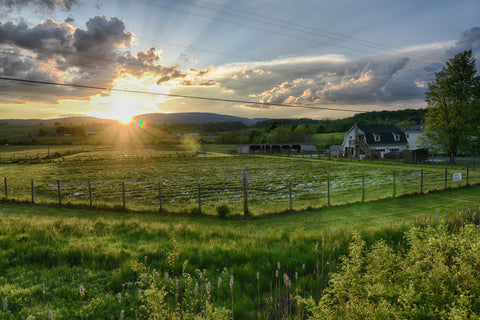
Moorefield, West Virginia: Confederate Bastion in the Blue State
Returning to the Shenandoah Valley after taking part in Lt. Gen. Jubal Early’s raid on Washington, D.C., and the burning of Chambersburg, Pa., both in July 1864, Confederate cavalry under Brig. Gen. John McCausland and Brig. Gen. Bradley T. Johnson bivouacked in the fields of Moorefield, W.Va. On August 7, Union Brig. Gen. William Averell and his men surprised the Confederates and pushed them back toward the South Branch of the Potomac River. The 3rd West Virginia Cavalry charged three times across the river and literally made the Confederates run for the hills surrounding the area. Averell captured four cannons, more than 400 men, and hundreds of hard-to-replace horses. “[T]his affair,” Early claimed, “had a very damaging effect upon my cavalry for the rest of the [Shenandoah Valley] campaign.”
Although largely Southern in sympathy, Moorefield housed whichever troops were in local control during the Civil War. The Confederate McNeill’s Rangers also operated in the area. Today, historic homes, shops, and eateries line Moorefield’s quaint Main Street, which boasts a handful of Civil War Trails signs within blocks of each other. A walking tour of the area includes not only Civil War–related sites, but several dwellings that date back to the town’s 18th-century inception, including the 1786 Higgins House, owned by Revolutionary War Captain Robert Higgins of the 8th Virginia.
Visitors to the area can also take a short drive to nearby Petersburg, W.Va., which houses the well-preserved dirt earthworks of Fort Mulligan, constructed during the latter half of 1863 to protect the South Branch Valley from Confederate forces. A stop atop the bluff where Maple Hill Cemetery rests offers some spectacular views of the mountains that not only envelop but adorn the tranquil valleys here today that, during America’s greatest conflict, were filled with the cacophony of musket and cannon fire.
Moorefield, WV battle site (Photo by Melissa A. Winn)
Run for the Hills
596 Harness Road
Brig. Gen. John McCausland’s troopers camped in this field while in Moorefield. On August 7, 1864, Brig. Gen. Bradley T. Johnson’s men forded the river and attempted to form a defense here with McCausland’s cavalry, but they were outflanked and outgunned. Brig. Gen. William Averell’s troopers chased the retreating Confederates into the surrounding hills.
Presbyterian Chruch, Moorefield, WV (Photo by Melissa
A. Winn)
Presbyterian Church
109 S. Main Street
The leader of this church, the Rev. William Wilson, and his congregation were strong Confederate sympathizers. Wilson left town in 1862 to become a chaplain in the Confederate Army. During the war, both sides used the church as a hospital. Union soldiers stabled their horses inside and burned pews as firewood.
McMechen House, Moorefield, WV (Photo by Melissa A.
Winn)
McMechen House
109 N. Main Street
Confederate sympathizer Samuel McMechen owned this 1853 home and its attached store on Main Street. McMechen entertained Confederate officers here when they controlled Moorefield. When Union forces occupied the town, McMechen left. Maj. Gen. John Frémont briefly made his headquarters here in May 1862, and Confederate Brig. Gen. John McCausland was asleep in an upstairs bedroom here when William Averell’s men surprised McCausland’s cavalry brigade camped in the fields around Moorefield.
Mullin Hotel, Moorefield, WV (Photo by Melissa A.
Winn)
Mullin Hotel
104 S. Main Street
Built in 1847, the Mullin Hotel was once known as the Moorefield Hotel Co., and the stockholders included Charles Carter Lee, eldest brother of Robert E. Lee. After the Civil War, it was operated by Captain C.B. Mullin who made it into a popular hostelry known for its food. During Captain Mullin’s tenure in the 1860s and 1870s, old hotel registers indicate that many men of distinction were guests. The 22-room hotel houses the 1847 Mullin Restaurant as well as the historical society museum.
Cemetery Hill, Moorefield, WV (Photo by Melissa A.
Winn)
Cemetery Hill
192 Olivet Drive
Fighting erupted among the tombstones on September 10, 1863, when Confederate troopers surprised Union troops camped here. The Union position was soon overrun. The Confederates captured 160 soldiers, 9 wagons, 46 horses, guns, and ammunition.
Fort Mulligan, Petersburg, WV (Photo by Melissa A.
Winn)
Fort Mulligan
100 Mulligan Drive, Petersburg
Constructed in 1863 under the command of Union Colonel James Mulligan, Fort Mulligan was built to protect strategically located Petersburg. The fort helped defend the important road network, prevent Confederate raids on the B&O Railroad and supported U.S. efforts in the new state of West Virginia. On January 31, 1864, Jubal Early’s men shelled the fort before discovering that it had been evacuated. Today the 5.5-acre park offers interpretive signs, reproduction cannons, and stunning vistas of the South Branch of the Potomac River.
Grove Cafe and Bakery, Petersburg, WV (Photo by
Melissa A. Winn)
The Grove Cafe & Bakery
26 Virginia Avenue, Petersburg
Dr. Thomas Grove built a residence here in 1854 and soon after built this small cottage to be used as his office and caretaker’s quarters. His property was used as a hospital during the Civil War, although he maintained strict neutrality. Today it serves up tasty treats, teas, coffees, and a West Virginia favorite: The Pepperoni Roll!
This article first appeared in America’s Civil War magazine
Facebook @AmericasCivilWar | Twitter @ACWMag
